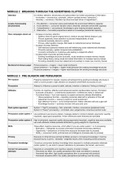MODULE BREAKING THROUGH THE ADVERTISING CLUTTER
Attention It is limited, selective, (in)voluntary and precondition for further processing of information
- Involuntary = unconscious, automatic, bottom-up/data-driven (“attractors”)
- Voluntary = conscious, intended, top-down/concept-driven (“magnetizers”)
Levels of processing 1. Pre-attention = consumer scans automatically the environment (little/no capacity)
(involvement) 2. Focal attention = consumer decides what is essential, attributes sense (little capacity)
3. Comprehension = use syntactic knowledge to give meaning (modest capacity)
4. Elaboration = formulate propositions based on knowledge (substantial capacity)
How campaigns stand out - Increase involuntary attention
- Saliency (hard to ignore original stimuli, medium arousal (Yerkes-Dodson Law)
- Picture superiority (more attention to pictures independently of size)
- Horizontal centrality (stimuli in centre)
- Primacy e ect (golden triangle, SEA leads to inattentional banner blindness)
- Increase voluntary attention
- Self-relevance (personal interest and self-referencing avoid inattentional blindness)
- Proximity (sensory, spatial, temporal and probabilistic)
- Curiosity (un nished or mysterious ads leading to Zeigarnick e ect)
- Increase ease of process (process uency)
- Existing knowledge structure (concrete, visual narratives increase memory traces)
- Dual coding theory (using visual and verbal information to increase memory traces)
- Encoding variability (novel but related stimuli (overlap) to create new memory traces)
Burnkrant & Unnava paper Picture presence + imagery = lower recall (confusion)
picture presence + no imagery = higher recall (because link existing knowledge structure)
No picture presence + imagery = higher recall (because link existing knowledge structure)
MODULE PRE-SUASION AND PERSUASION
Pre-suasion Preparing recipients for request, requires activating/priming existing knowledge structures in
order to communicate in right direction (in situations where MOA to process is low)
Persuasion Attempt to in uence a person’s belief, attitude, intention or behavior (“linking is thinking”)
Attitudes Function of cognitive, a ective and behavioral reaction ((un)favorable manner). Formation:
- Automatic evaluation = unintentional assessment, “preferences need no inferences”
- Functional theory = four main reasons to explain someone’s attitude (like/dislike):
- Value-expressive function = signaling consumer-ideal self or extension of the self
- Adjustment function = receive a reward or avoid punishment
- Ego-defensive function = avoid embarrassment, relation between self and ought self
- Knowledge function = summary function with pros and cons
Dual system approach System 1 (“light”) processing = fast, automatic, intuitive, unconscious (peripheral route)
System 2 (“heavy”) processing = controlled, slow, judgemental, conscious (central route)
Persuasion under system 1 Use peripheral cues (source-related, message-related or product-related), arguments’ quantity
important, signal good properties, if-then inferences (naïve theories) are activated
Persuasion under system 2 High involvement, argument quality (strong arguments) important, cognitive resources available,
use multi-attribute models (evaluate attributes by giving weights for importance)
MOA These a ect cognitive resources, which a ect if you are under system 1 or 2 processing:
- Motivation = willingness to process information (increase (in)voluntary attention)
- Opportunity = distractions or limited time exposure (increase ease to process)
- Ability = consumer’s skills, pro ciencies and intelligence (increase ease to process)
Priming Exposure to initial stimulus (prime) facilitates access to conceptual knowledge in memory
(Duracell bunny is prime, “durability” weighted heavily when evaluating similar products)
Persuasion knowledge Conscious consumers develop knowledge when exposed to multiple persuasion attempts
(under system 2), use tools to prevent resistance to persuasion (be honest, use humor)
Correct for persuasion Depends on accessibility and cognitive capacity. Inverted U shape:
attempts - Perceived low e ort, low quality perceptions ( rm does not believe in product)
- Perceived high e ort, high quality perceptions ( rm is concerned with product)
- Perceived excessive e ort, low quality perceptions (something must be wrong
ff ff fifl3
2 ffff ffff fi fl ff fi fi ff





